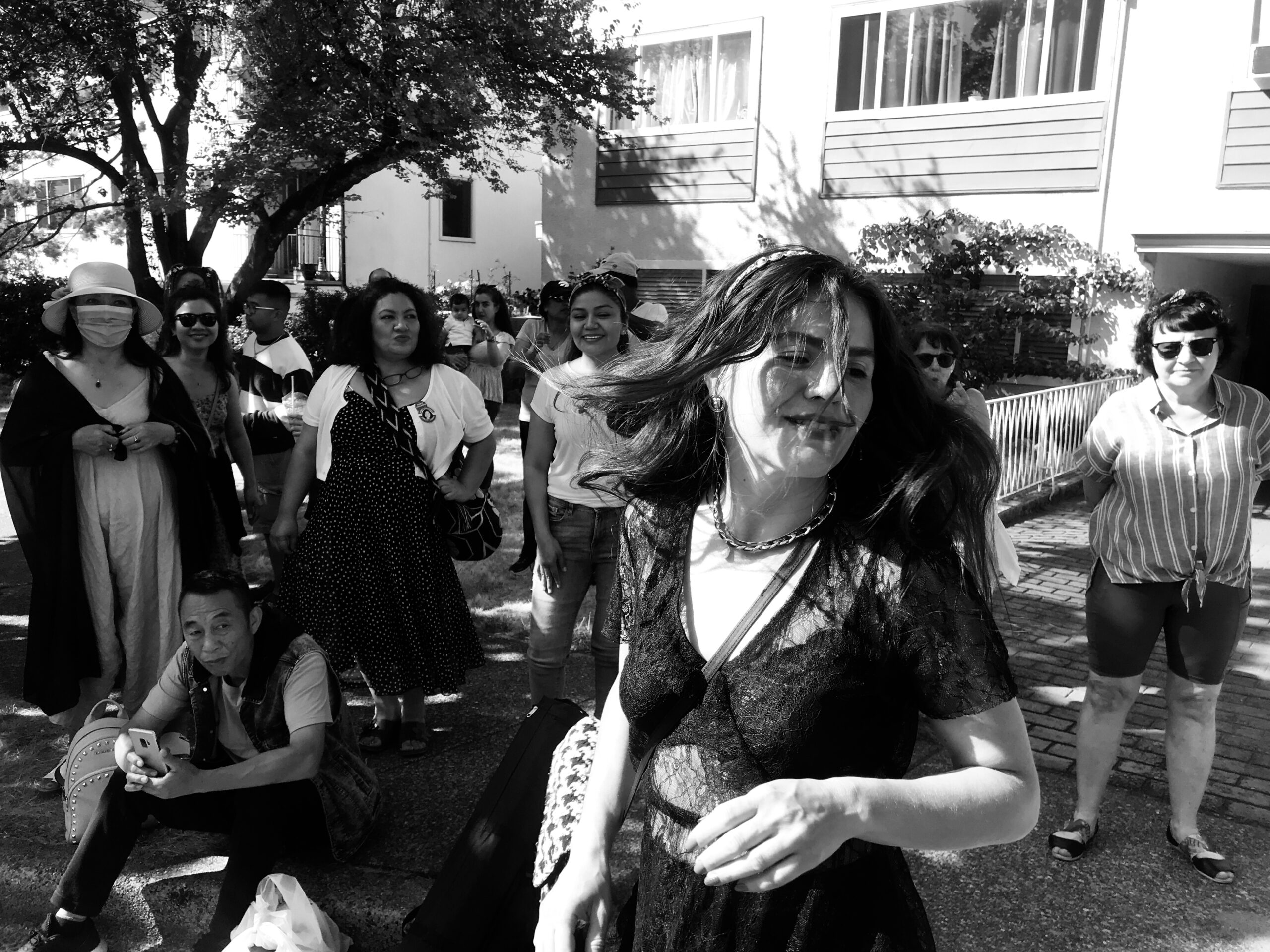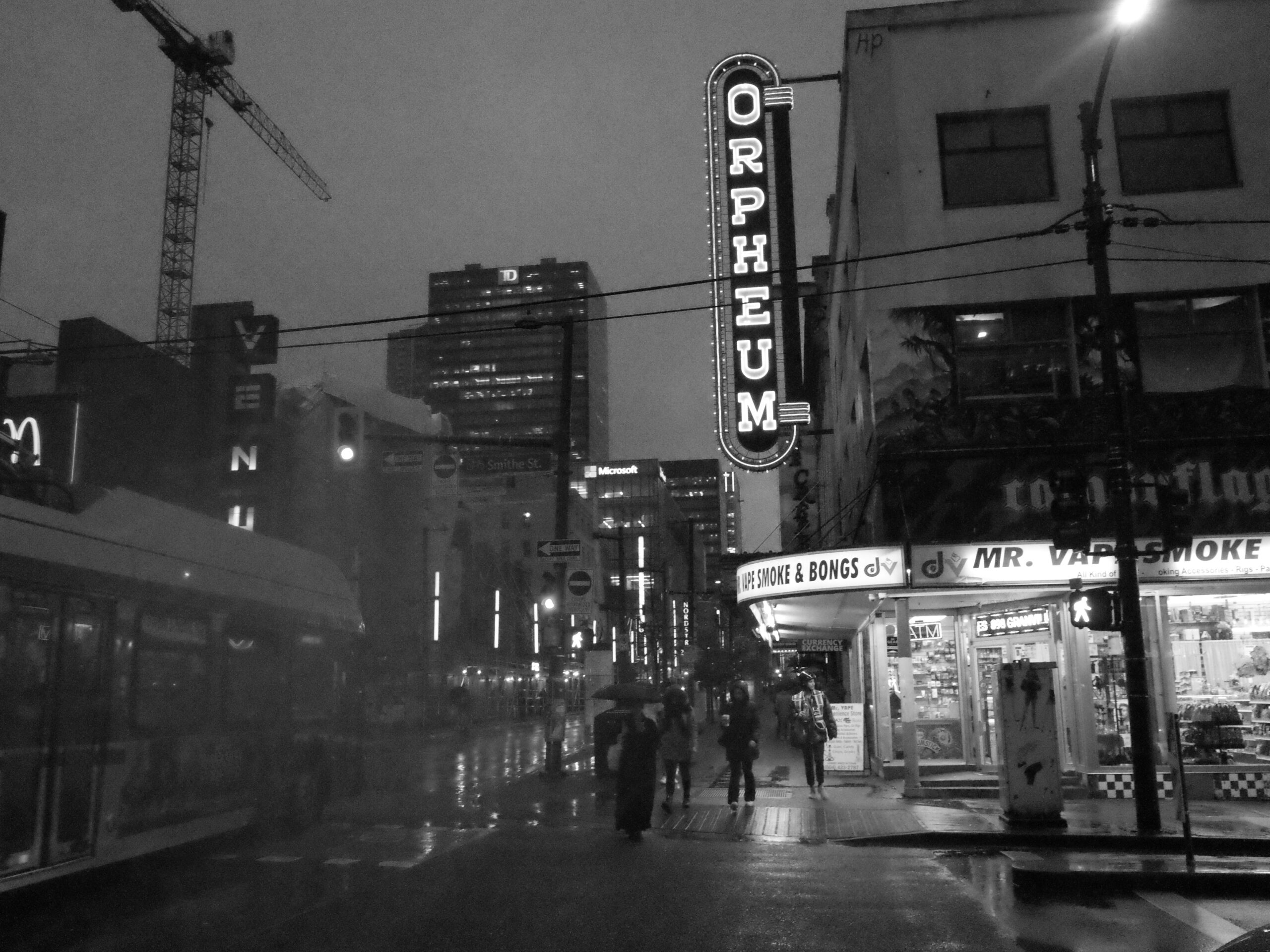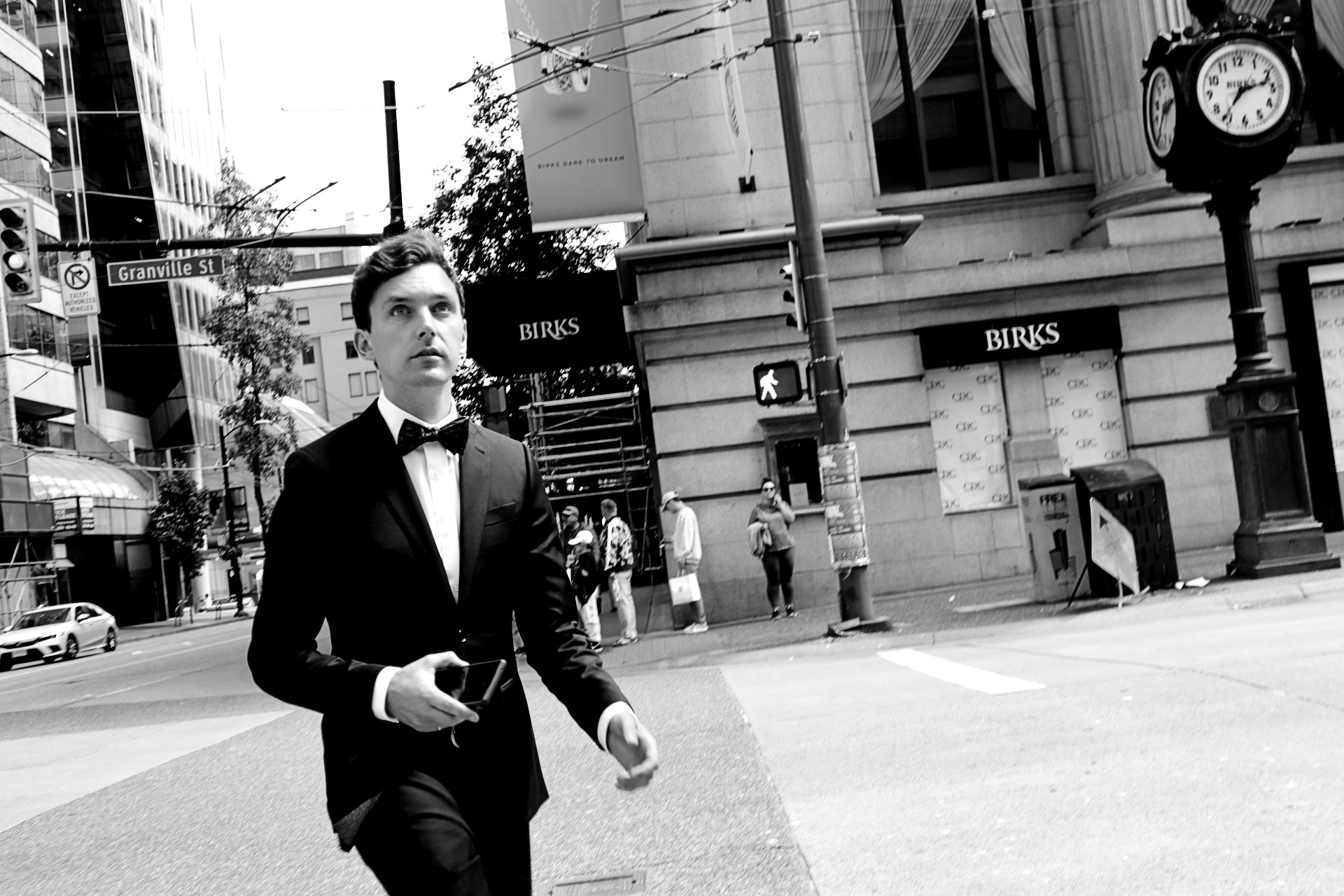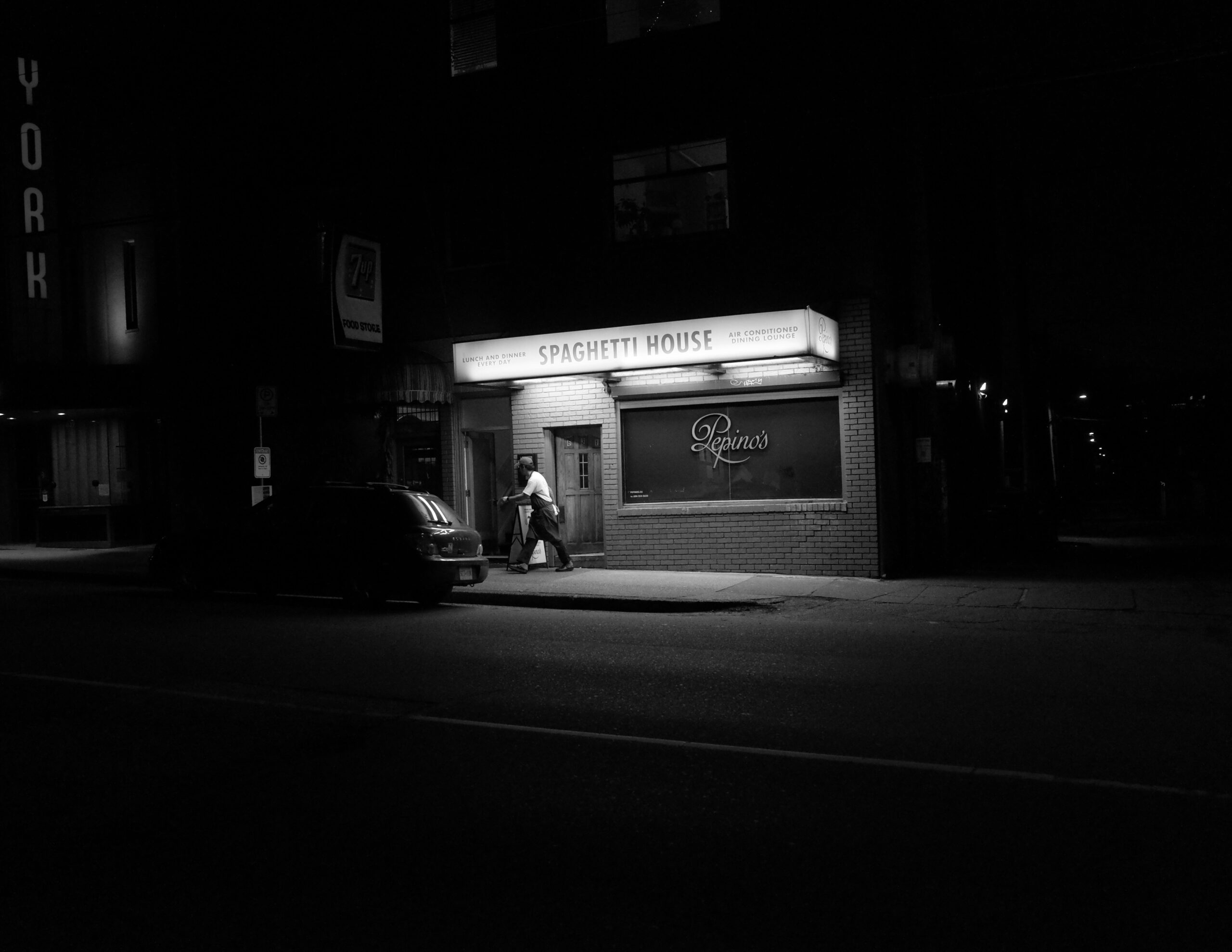Street photographer Rodney DeCroo says he has zero interest—he puts an expletive in there for emphasis, then repeats the phrase for still more emphasis—in photographing “hipsters in $500 jeans” on their way to some punk rock show. He’s also not interested in the “very composed” shots he sees, taken by some contemporary street photographers, “where there’s a tiny profile of a person walking, and there’s a shot of a ray of light coming between two enormous skyscrapers. And they waited there, when they noticed that shaft of light was coming through. It’s all very well done, technically. And a lot of that is about how anonymous and how tiny we are in the face of modern society. And I’ll be honest: it doesn’t interest me that much.”
By contrast—even in reaction—DeCroo is interested in “the guy who, maybe he’s 52, he’s been living on the Drive for 30 years, maybe he’s always been single, and he’s going to walk into SuperValu to get some cat food and some lunch meat to make sandwiches for work tomorrow.” We are sitting at the Continental Coffee House on Commercial Drive as he tells me this, two blocks from that SuperValu now a FreshMart, and walking distance from his own home, just off the Drive. Best known as a singer-songwriter and poet, DeCroo is a wide-ranging artist who has also branched out into live theatre and even cinema. For those unfamiliar with his work, he gives a very personal accounting of his background in his one-man 2019 theatrical piece, Didn’t Hurt, which details a traumatic childhood in Western Pennsylvania and lifelong PTSD, mostly suffered as a result of abuses at the hands of his stepfather. The whole performance is on YouTube. It’s at times harrowing stuff, not to be watched lightly. Similarly dark, DeCroo’s last full-length album, 2017’s Old Tenement Man, also draws heavily on his childhood and PTSD, as does his 2023 book of poetry, Fishing for Leviathan.
His interest in capturing the daily life of the people of East Vancouver in images is relatively recent, stemming from the period after Old Tenement Man, when he realized there was a disjunction between his songs and poetry and the city he lives in. He began to look at street photography online. Vancouverite Fred Herzog was an inspiration, as well as New Yorker Vivian Maier (“but everybody mentions her”). Filmmaker and photographer Robert Frank’s raw, intimate portraits of American street life also drew his interest, “but he’s very different from me.”

From Night Moves. Courtesy of Anvil Press.
DeCroo feels a kinship with New York photographers like Jill Freedman, Garry Winogrand, and Joel Meyerowitz. Meyerowitz’s colourful and playful street photography shows what DeCroo calls a “generous spirit.”
He continues, “And I adore Helen Levitt, especially in that she was so focused on one neighbourhood for so long, chronicling the joy of kids in those New York streets,” he continues. The work of these photographers suggested “new ways to tell stories,” or at least ways that were new to him.
While the odd abandoned urban landscape appears in DeCroo’s work, as well as forays outside his East Vancouver haunts, the Anvil Press book of his photography, Night Moves, focuses on the people of Commercial Drive. “The book goes all over the east side,” DeCroo says. “There are photos from the PNE, from Chinatown, from Mount Pleasant, from Hastings Sunrise.” But the “heart” is the area where we are now sitting.

From Night Movies. Courtesy of Anvil Press.
There’s good reason for his interest in the neighbourhood. “This area gave me a life,” he explains. “I’ve lived here for 33, 34 years now. When I showed up here, I was writing poetry, and I thought I was just some freak, because I was this young, deeply traumatized, occasionally violent addict-alcoholic from a redneck background in Western Pennsylvania, and yet I’m walking around reciting John Donne poems.”
When he first came to Vancouver, in 1985, rent was cheap, and DeCroo, still reeling from his painful childhood, found he could live on welfare—“which everybody did, back then, if you were going to be an artist”—and sit at the Continental, drinking three or four of “these giant mochas that they would make in Mason jars, with whipped cream on them. I’d be sitting here reading a book of poetry, and somebody else my age would be, like, ‘Oh, you like poetry?’ And I’d start talking to them. I discovered that, Holy shit, there’s people here calling themselves poets. There’s people here who play songs that they write themselves. I didn’t have that in Pittsburgh. That was never even a possibility. There were times when I was a kid that I would write stuff—it just poured out of me. But I hid it. I was embarrassed by it. My English teacher, one time, went into my desk and found some of the pages that I had written and read one of them aloud to the class, much to my horror, and said, ‘This is poetry! Rodney’s a poet.’ I think I had two fights that afternoon, because people were like, ‘You’re gay!’”
The Continental itself is the subject of one of DeCroo’s recent poems, in which he describes “sitting in the café reading books, drinking coffee, smoking cigarettes, and staring into space.” At first he describes needing “time to write,” he tells me, but “by the end of the poem, I say, ‘maybe I just needed time,’ you know?”
It wasn’t the only important spot on the Drive. La Quena—“a socialist-anarchist café that did a lot of solidarity events for Latin America,” formerly located at 1111 Commercial—gave DeCroo the perspective to start thinking about his life experiences in terms of class. “Like, ‘Hey, you’re really fucked up because you’re from this background, but there’s economic reasons for that—here’s Marx, read him!’”
Pofi Bar, a “notorious place” at Charles and Commercial rife with drug deals, fenced goods, and unlicensed, after-hours alcohol sales, was another comfortable environment, early on, when “the rest of this city didn’t make much sense to me…. It’s kind of a haphazard way of describing it, but I found a home here,” he explains. “But for almost 30 years, I didn’t call it my home. I called Pittsburgh my home. So this was really bothering me. It’s not like anyone in East Vancouver was losing sleep about whether I was making art about this neighbourhood, but I was feeling like I needed to close the gap between my work and my home.”
Early in DeCroo’s explorations of photography as a medium, “I would hang out at bus stops and take pictures with my phone, sort of secretly.” (He’s since tried a couple of compact cameras designed for street photography but now works “almost exclusively” with his iPhone 14, which is less intimidating than an actual camera and produces images every bit as good).

Those early photographs don’t hold much interest for him now, he says, but he adds that he was “unwittingly learning. Because that’s what I do. I go through a period of apprenticeship where I suck, but I’m so obsessed with it, I keep doing it. I remember when I decided to become a songwriter, it drove my roommates nuts. I’d sit in the living room all day, teaching myself guitar at, like, 30. And I’d literally sing the chord changes—Geee…, Ceee…, Deee—because I wanted to marry the singing with the playing rather than try to build one up and then put the other in. And it was driving them insane, because I would do it for hours a day. And I started writing songs right away, and they were just horrible. And I’d drag my guitar around the house playing these songs. Eventually I’d clear the room, and then I’d follow them into the other room until somebody would say, ‘Hey, Rodney. Put the guitar away for a while, man, just come hang out.’ But what they were really saying was ‘STOP! PLEASE! STOP! Nobody wants to listen to you!’”
He remembers someone—the “epitome of a beatnik”—listening to him earnestly strumming in the kitchen at a house party in Mount Pleasant and then remarking, “That was awful.” Unflappable, DeCroo responded, “Yeah, I know, but I’m going to get better.” To which the beatnik wannabe said dismissively—DeCroo mimes taking a long draw on a cigarette—”Why don’t you come back then?”
DeCroo has come a long way since my first meeting with him, when MONTECRISTO Magazine contributor Adrian Mack introduced us at the Railway Club, circa the time of his first album, 2007’s War Torn Man. DeCroo had long, greasy hair in his eyes and seemed awkward, shy, and yet intelligent—but as if most of that intelligence was still trapped inside. I remember feeling intrigued, but not all that comfortable.
By contrast, he now speaks confidently, relaxedly, even offering the odd joke at his own expense. Almost none of what you read here is the result of anything I asked him. We just sat down, and he said what he had to say. By the time he got around to asking if I had questions, he’d already answered most of them.

It’s a hard-won self-confidence, the strongest kind: he knows himself as well or better than any artist I’ve spoken to. And knowing his own processes—and having “tenacity about this sort of stuff”—allowed him to recognize his own street photography trajectory. “I had been through this process before with other art forms, so I started to go, ‘Oh, I recognize the stages.’”
One day he was standing at 1st and Commercial, taking photographs, when he realized he had broken the barrier between being interested in street photography and being a street photographer. “It was a summer day, it was beautiful, I was just taking photos. And I know tons of people here, so every few minutes somebody would stop and talk to me. And I went, ‘Holy fuck, I’m doing it. I’m making art of my neighbourhood. Not about my neighbourhood, but I’m using my neighbourhood as the materials for the art. And then I went, ‘I’m doing it. I’m doing it!’”
DeCroo was encouraged by friends, especially on social media, where he’s shared his work. Then Brian Kaufman, in 2021, asked if he could run a photo with some of DeCroo’s poetry in the Vancouver literary magazine SubTerrain. “And then shortly after that, Richard Mackie of British Columbia Review asked me if I would be interested in doing a street photography feature for them. That would have been 2022, and that got a lot of traffic.” Then Kaufman suggested that Anvil Press—who had published Fishing for Leviathan—do a whole book on DeCroo’s images.
Street photography has given DeCroo a sense of “real relief” from his usual inward focus, he explains. And he now feels a real “sense of urgency” in getting the book out there. As he says, the Drive of 1989 is not the Drive of 2000, and the Drive of 2000 doesn’t look much like the Drive of today. “This area is gentrifying quickly,” he concludes. “And I want to capture something of it that I recognize before it’s gone. Photograph people we often overlook, who, when they walk down the street, you probably don’t see them, but who are kind of part of this neighbourhood.”
Night Moves is due out from Anvil Press April 1, 2025. A launch event will take place April 23 at the VIFF Centre, featuring musical performances and more.









